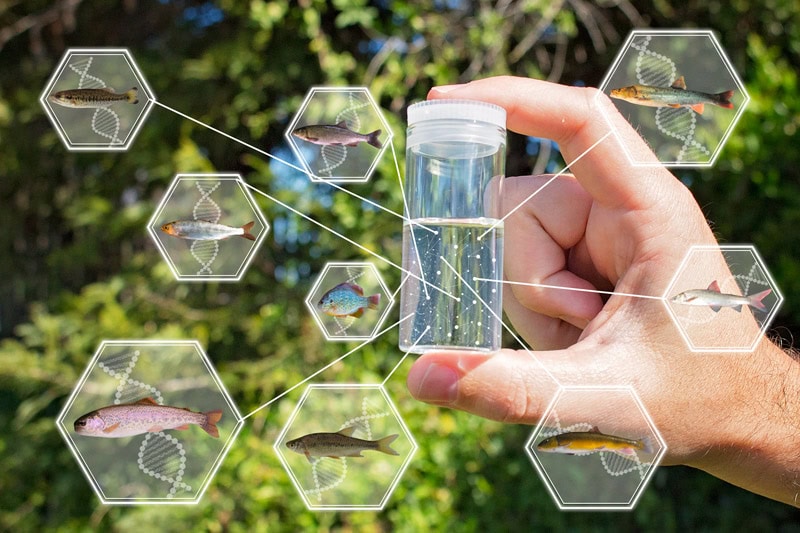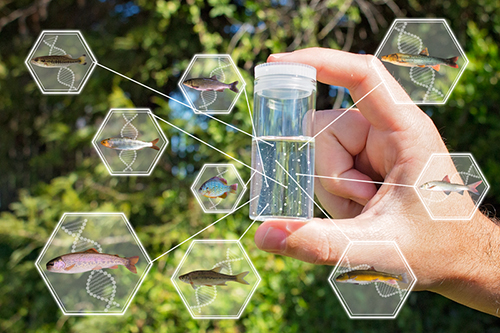Exploring eDNA: Detection in a Drop of Water
Well, you’ll need more than a drop, but the increasing capability of this emerging scientific tool is leading to the exciting possibility of its use in mainstream (pardon the pun) citizen science applications.

Image source
eDNA: What is it?
eDNA, or environmental DNA, is simply any genetic material that has been released into a system by a living organism. This can include skin cells, urine, or hair from an animal, but it also applies to plants! eDNA is found in both terrestrial and aquatic systems, in soils, sediments, and free in the water column. eDNA has been used to study the evolutionary history of mammals, plant diet of ancient megafauna, detection of rare amphibian species, and increasingly, eDNA has become a critical tool in monitoring aquatic ecosystems for invasive plants, fish, and macroinvertebrates.
The use of eDNA to determine invasive species presence or absence is especially useful in aquatic systems because many of these invaders utilize every nook and cranny beneath the water’s surface and go easily undetected using traditional sampling methods. eDNA also allows us to detect more than what can be seen with the naked eye. During a standard aquatic survey, we may toss in a rake an pull up a collection of native water celery, but miss that new infestation of Hydrilla that’s just beginning to grow. eDNA sampling gives us a greater chance of early detection.
How it works
For aquatic systems, water is filtered through a sampling cup and DNA is left behind on the paper filter, which has microscopic holes to allow the water to pass through but holds onto genetic material. That filter is then processed in a lab, where the DNA is amplified using genetic markers, called primers, of either a single species, or a non-specific gene that can be used to detect multiple species. This amplification is what allows researchers to determine whether or not a species may be present in a system!
eDNA and its Future in Citizen Science
Thus far, many of the research and collection of eDNA samples has been limited to professional scientists and laboratories. However, after years of being employed by researchers, the methods have become more streamlined and the costs have decreased with more laboratories performing eDNA testing. This has opened the doors for several up-and-coming citizen science eDNA projects all over the world, such as measuring biodiversity in California, detecting the Great Crested Newt in the United Kingdom, and the hunt for invasive fish by school groups right in our own back yard!
Using eDNA in citizen science projects has numerous benefits to traditional sampling. For one, safety of volunteers is of utmost importance, and the ease of simply collecting a water sample alleviates many safety concerns. Additionally, it may take someone hours to survey one body of water using the standard rake toss method for collecting aquatic plants, but many water samples can be collected from several sites in that same amount of time. The use of eDNA also means that citizen scientists aren’t required to be able to correctly identify specimens, which is one of the most challenging aspects of aquatic plant and animal surveys.
As of now, there are still a limited number of labs open to eDNA testing. We hope that as the technology continues to develop, we’ll see more and more eDNA projects for citizen scientists that will increase our capacity to monitor for the hundreds of cryptic aquatic invasive species throughout the Lower Hudson.

About the Author
Lindsay Yoder
In addition to being the new Aquatic Programs Coordinator, I am also currently earning my degree in Fisheries and Wildlife Sciences with a focus in aquatic ecosystem management. I have been immersed in the world of aquatic invasive species for a year and a half and continue to learn something new every day. Did you know that there’s an invasive fish called the Northern Snakehead with ferocious teeth that can survive on land for up to four days? Now you do, but I bet you wish you didn’t!
Get involved
Interested in getting involved? Check out these upcoming citizen science and stewardship opportunities:
-

Christmas Bird Count Kick Off With Charlie Roberto (Adults)
Teatown 1600 Spring Valley Rd, Ossining, NYKick off Count Week for the 126th Annual Christmas Bird Count with Charlie Roberto.
-

Christmas Bird Count (Adults)
Teatown 1600 Spring Valley Rd, Ossining, NYJoin Director of Education Emily Edmonds-Langham and other Teatown birders for the official count.


